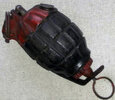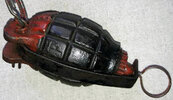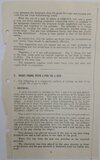It certainly has the form of a booby trip, with the trip pin removed as far as possible from the lever fulcrum at the lugs.
In WWII the Aussies demonstrated an obsession and unending ingenuity for modifying the No.36 grenade as a booby trap, and the National Archives of Australia, Melbourne, holds quite a number of files from various inventors, often serving soldiers. An example submitted by Lt R H Patterson, and that was at least included in an army training memorandum, is shown in the two pages attached.
Early booby traps used a tripwire acting on the standard ring pull, often with the pin inserted through just one pin hole to partially intrude on the lever. However, the combined force of the lever on the pin so close to the lever fulcrum, and the friction of the pin in the holes in the lugs, made it unworkable as a sensitive booby trap. By moving a retaining pin further down the length of the lever, the lateral force of the lever against the pin was reduced and the pin could be tripwire-extracted with ease. The Patterson example consists of a simple wire clip conversion kit that fits in one of the horizontal serrations.
The device in Anders' photos is not necessarily of Australian origin (the No.36 shown is actually of South African manufacture), but it demonstrates the point that Lt Patterson described, of moving the trip pin as far down the lever as possible; in this case with the added benefit of a lengthened lever. Patterson also suggested an instantaneous fuze rather than the usual 4s time fuze, and the advice was to mark instantaneous with red painted sections.
Other than the extended lever and trip pin socket that screws into the base plug, the main safety pin is also a slightly different pattern to the usual No.36 - it is a dual pin with a pair of holes in each lug.




